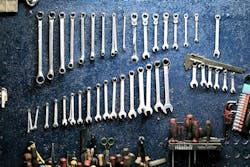Technology: The Driver of Change
With over 25 years of experience on the aftermarket and OE side of parts, Jon Palazzo, vice president and general manager of the mechanical & fleet division at OEConnection (OEC), has seen how trends influence and shape where the parts industry is headed. Because of his exposure, Palazzo foresees changes that will take place in the next 10 years and for what mechanical repair shops need to start preparing.
What is driving change in the mechanical repair industry?
We’re already seeing electric cars, cars that park themselves, rideshare and autonomous vehicles all over the headlines of magazines and newspapers. The services are intriguing, but what’s most interesting to look at is the technology needed for a car to drive itself or to allow a person to utilize a rideshare program. In order to make these advancements, technology is needed that wasn’t in the marketplace 10-11 years ago.
With new business and new players coming into the industry to create their own niches, they all, to some level, are bringing new technologies with them and/or their services have significant dependencies on technology. This is naturally driving OEMs (vehicle manufacturers) and tech companies to also partner. All of these new players and new relationships have accelerated the rate of technology faster than we’ve ever seen before, which drives significant changes at a much faster rate in the repair industry as well.
How does this impact how vehicles are serviced?
Cars are almost designed from the inside out now. Historically, it’s been the opposite of that. Car guys were/are all about the exterior lines of a vehicle, but that’s no longer the case for everyone. Now, people are asking, “Do I have to drive it all of the time?” “Is it compatible with Android and Apple?” That synergy between technology and vehicles is important to buyers, and shops will need to prepare for that.
Repair shops will need to find ways to get more data and more information on the technology used in vehicles and may need to start specializing in different systems or vehicle platforms. For example, you may need to specialize in repairing electric car platforms only in the future, which is kind of opposite from the repair trends we’ve seen in just the last 12 years or so.
Do you think there are trends in the collision industry that you think will trickle over to the mechanical side?
I would say that, in general, basic mechanical repair compared to collision repair is less complicated. One reason for this is there are so many more hands in the pot when it comes to collision—from insurers to the shop to the OE to the customer. Another driver is 6-8 of every 10 parts purchased by collision repairers is an OEM part. With mechanical, it’s not like that, but it could be headed in that direction.
With vehicle ownership shifting—I think it’s something crazy like 33 percent of Americans have heard of rideshare and 15 percent have used it—the authority for how the car is repaired and serviced will shift. In a few years, the driver that brings the vehicle in may have no say as to what’s done with the car. You’re going to start to see more fleet ownership. With this will come more process-driven and formal repairs. Because of this, repair procedures that we’ve seen on the collision side will start to pop up for mechanical repairs.
Because of the rapid technology advancements, it seems likely that dependencies between the OEMs, dealerships and shops will increase. In what ways will we start to see this?
At the end of the day, the dealership doesn’t have its name on the car. Independent repair shops don’t have their name on the car—the OEM does. If a customer buys from an OEM and they have a negative repair experience, even if it’s not at a dealership, 7 out of 10 times, they’ll likely go to a different brand. Retention is always top of mind for OEMs, which is why customer service is so important. OEMs need to make sure that customers have a flawless experience, whether it’s at one of its dealerships or elsewhere. When cars run out on their warranty, it’s more common for consumers to take their vehicles to independent repair facilities rather than a dealership.
OEMs are either going to need to build more dealerships, create more bays at those dealerships, or partner with existing facilities. The least expensive option, and the one that I think we’re going to see an increase in, is for OEMs to encourage partnerships between dealerships and independent repair shops.
Jon Palazzo
Vice President and General Manager of the mechanical & fleet division at OEC
